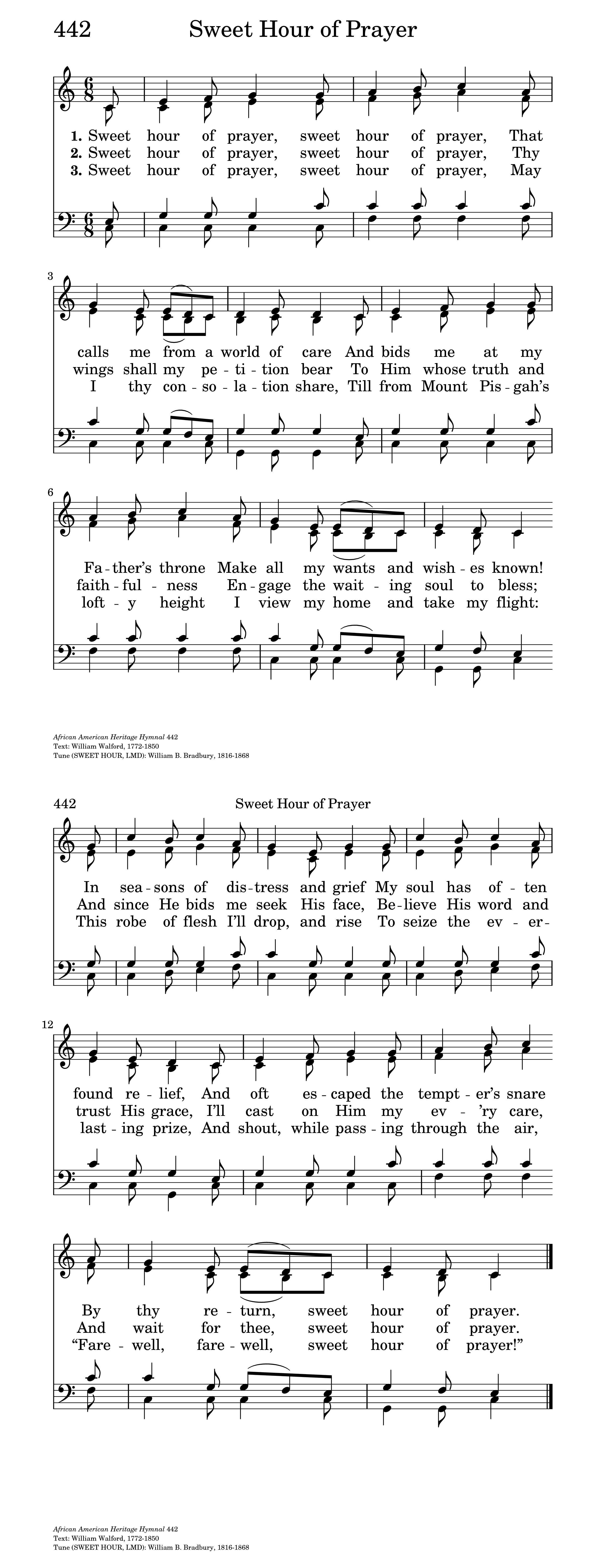that calls me from a world of care,
and bids me at my Father's throne
make all my wants and wishes known.
In seasons of distress and grief,
my soul has often found relief,
and oft escaped the tempter's snare
by thy return, sweet hour of prayer!
2. Sweet hour of prayer! sweet hour of prayer!
the joys I feel, the bliss I share
of those whose anxious spirits burn
with strong desires for thy return!
With such I hasten to the place
where God my Savior shows his face,
and gladly take my station there,
and wait for thee, sweet hour of prayer!
3. Sweet hour of prayer! sweet hour of prayer!
thy wings shall my petition bear
to him whose truth and faithfulness
engage the waiting soul to bless.
And since he bids me seek his face,
believe his word, and trust his grace,
I'll cast on him my every care,
and wait for thee, sweet hour of prayer!
The beloved hymn “Sweet Hour of Prayer” was written by William W. Walford, a blind English lay preacher, and first published in 1845. Its touching message and simple yet heartfelt language have made it a lasting favorite in churches around the world. The hymn speaks of the comfort, power, and spiritual refreshment found in time spent in prayer, portraying it as a precious hour where the soul draws near to God and finds peace, strength, and hope.
William Walford was born in England around 1772. Though blind from a young age, he was deeply committed to his faith. He was known to be a man of prayer, a devoted student of the Bible, and someone who memorized large portions of Scripture. Despite his physical limitation, he served as a preacher in his local church and operated a small trinket and woodcraft shop in his village. It is said that Walford could quote entire chapters of the Bible by heart, and he often composed sermons and verses mentally, dictating them to others.
The story of how “Sweet Hour of Prayer” came to be known and published is itself humble and touching. In the early 1840s, an American minister named Thomas Salmon, who was living in Coleshill, Warwickshire, England, became acquainted with Walford. During one of their conversations, Walford dictated to Salmon the verses of a poem he had composed on the subject of prayer. Deeply moved by the poem’s sincerity and beauty, Salmon wrote it down and later brought it with him to the United States.
In 1845, the poem was published anonymously in the New York Observer, a religious periodical, under the title “Sweet Hour of Prayer.” The poem resonated deeply with readers, especially in an era when revivals were common, and personal devotion was highly valued. Over time, the words were set to music by William B. Bradbury, a prominent American composer of hymn tunes. Bradbury’s melody, gentle and flowing, perfectly matched the contemplative and comforting spirit of Walford’s text, helping to elevate it to enduring popularity.
The hymn’s three stanzas describe a progression in the experience of prayer. The first stanza emphasizes prayer as a time of communion with God—a refuge from the cares and griefs of life. It paints a picture of the soul escaping from the burdens of the world to find solace and spiritual refreshment.
Sweet hour of prayer, sweet hour of prayer,
That calls me from a world of care,
And bids me at my Father’s throne,
Make all my wants and wishes known…
The second stanza focuses on the power of prayer to bring comfort in times of distress and uncertainty. It testifies to the way prayer strengthens faith, draws the heart toward heaven, and connects the believer to divine promises.
The third stanza looks forward to the hope of heaven. It expresses a desire to leave behind earthly burdens and meet the Lord face to face. The line “And shout while passing through the air, Farewell, farewell, sweet hour of prayer” is particularly striking—it envisions the end of life not as a loss, but as a glorious beginning, where prayer is no longer needed because the soul is in direct presence with God.
Though not much else is known about William Walford’s life, his hymn continues to speak for him. His blindness and simple station in life did not prevent him from composing one of the most enduring expressions of Christian devotion. His hymn stands as a testament to the richness of a life rooted in prayer, and to the truth that God often uses quiet, humble voices to inspire generations.
“Sweet Hour of Prayer” remains a deeply loved hymn in evangelical, Methodist, Baptist, and many other church traditions. It has been included in hundreds of hymnals and sung in countless worship services, prayer meetings, and quiet moments of personal reflection. Its enduring appeal lies in its gentle melody and timeless message—a reminder that in the busy and often harsh world, the soul finds rest and strength in the sweet, sacred hour spent in communion with God.



No comments:
Post a Comment